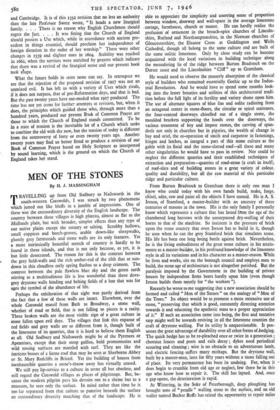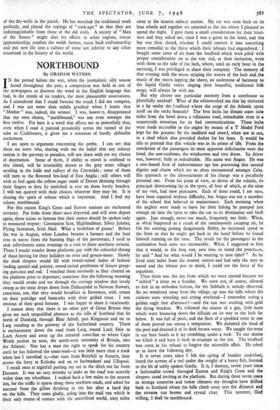MEN OF THE STONES
By H. J. MASSINGHAM
TRAVELLING up from Old Sodbury to Nailsworth in the south-western Cotswolds, I was struck by two phenomena which jutted out like bluffs in a jumble of impressions. One of these was the extraordinary diversity of the English landscape. The country between these villages is high plateau, almost as flat as the Midlands plain, but with broader, simpler effects than any type of our native plains except the estuary or salting. Scrubby hollows, small coppices and beech-groves, arable down-like sheepwalks, ghostly grey farmsteads and stone walls are its only features. Yet a more intrinsically beautiful stretch of country is hardly to be found in these islands, and that is not only because, as yet, it is but little desecrated. The reason for this is the contrast between the grey field-walls and the rich umber-red of the tilth that at sun- down in this cloudless early spring flushes to a deep crimson. The contrast between the pale flawless blue sky and the green earth stirring to a multitudinous life is less wonderful than these dove- grey drystone walls binding and belting fields of a hue that was for ages the symbol of the abundance of life.
Perhaps the exhilaration of that sight was partly derived from the fact that a few of these walls are intact. Elsewhere, over the whole Cotswold massif from Bath to Broadway, a stone wall, whether of road or field, that is not falling to pieces is a rarity. These broken walls are the most visible sign of a great culture in stone fallen upon evil days. The villages that link this expanse of red fields and grey walls are so different from it, though built of the limestone of its quarries, that it is hard to believe them English at all. Old Sodbury and Nailsworth might be of the Pyrenees or Apennines, except that their steep gullies, bold promontories and wild tossing surfaces are mantled with turf. They are like the intricate bosses of a lierne roof that may be seen at Sherborne Abbey or St. Mary Redcliffe in Bristol. Yet the building of houses from inexhaustible quarries a stone's-throw away has virtually ceased.
We still pay lip-service to a culture in stone all but obsolete, and still regard the Cotswold villages as places of pilgrimage. But, be- cause the modern pilgrim pays his devoirs not to a shrine but to a museum, he sees only the surface. In mind rather than time he is too far separated from that culture to perceive beneath the surface an extraordinary diversity matching that of the landscape. He is able to appreciate the simplicity and unerring sense of proportion between window, doorway and wall-space in the average limestone • cottage, farmhouse, church or manor. He can hardly realise the profusion of ornament in the broach-spire churches of Lincoln- shire, Rutland and Northamptonshire, in the Norman churches of Gloucestershire, the Eleanor Cross at Geddington and - Wells Cathedral, though all belong to the same culture and are built of the same oolitic limestone. Only by close study can he become acquainted with the local variations in building technique along the meandering lie of the ridge between Burton Bradstock on the Dorset coast and the Lincolnshire " Cliff " up to Grantham.
He would need to observe the masterly absorption of the classical style of builders who remained essentially Gothic up to the Indus- trial Revolution. And he would have to spend some months look- ing into the lesser beauties and utilities of this architectural tradi- tion before the full light of its fertility and variety shone upon him. The use of alternate squares of blue lias and polite radiating from an octagonal centre in stone-floors, the circular or spiral staircases, the four-centred doorways chiselled out of a single stone, the moulded brackets supporting the hoods over the doorways, the various treatment of key and impost stones, the carving of span- drels not only in churches but in pigsties, the wealth of change in bay and oriel, the co-operation of smith and carpenter in fastenings, hinges and latches, as integral a part of this stone culture as the gable with its finial and the stone-slatted roof—all these and many other singularities he would have to pass in review. Nor could he neglect the different quarries and their established techniques of extraction and preparation—quarries of road-stone (a craft in itself), of roof-slats and of building stones in a great variety of colour, quality and durability, but all the raw material of this particular ridge and particular culture.
From Burton Bradstock to Grantham there is only one man I know who could today with his own hands build, make, forge, chisel, adze, saw and paint all the objects I have named. He is A. S. Ireson, of Stamford, a master-builder with an ancestry of three centuries of masons in the town. His is the only family I personally know which represents a culture that has lasted from the age of the chambered long barrows with the unsurpassed dry-walling of their horns to that of the machine. So insistent is the pressure of brick upon the stone country that even Ireson has to build in it, though he uses when he can the grey Stamford brick that simulates stone. His life has been one long losing battle against brick. Nevertheless, he is the living embodiment of the great stone culture in his attain- ments as a master-builder, in his profound knowledge of the limestone style in all its variations and in his character as a master-mason. While he lives and works, sits on the borough council and employs men to build, the stone age of architecture is not altogether perished. But the paralysis imposed by the Government in the building of private houses by independent firms bears hardly upon him (even though Ireson builds them mostly for " the workers ").
Recently he wrote to me suggesting that a new association should be formed and called " Men of the Stones " on the analogy of " Men of the Trees." Its object would be to promote a more extensive use of stone, " preserving that which is good, constantly directing attention towards it and educating the apathetic mass to a proper appreciation of it." If such an association came into being, the first and tentative step might well be towards reviving in• all the limestone counties the craft of drystone walling. For its utility Is unquestionable. It pos- sesses the great advantage of durability over all other forms of hedging. The quick hedge has to be re-pleached once or twice in a generation ; chestnut fences and posts and rails decay ; dykes need periodical scouring and cleaning ; wire is no obstacle to an adventurous lamb, and electric fencing suffers many mishaps. But the drystone wall, built by a master-man, lasts for fifty years without a stone falling out of place. Its very permanence has been its undoing. For, when it • does begin to crumble from old age or neglect, few there be in this age who know how to repair it. The skill has lapsed. And, once a gap opens, the deterioration is rapid.
At Wittering, in the Soke of Peterborough, deep ploughing has brought tons of " pendle " walling stone to the surface, and an old waller named Bocker:Rolle has seized the opportunity to repair miles of the dry-walls in the parish. He has matched the traditional work perfectly, and placed the copings of "cock-ups" so that they are indistinguishable from those of the old walls. A society of "Men of the Stones " might abet his efforts in other regions, rescue apprenticeship, comfort the wolds farmer, nurse back craftsmanship and put new life into a culture of stone not inferior to any other renowned in the history of the world.



























 Previous page
Previous page